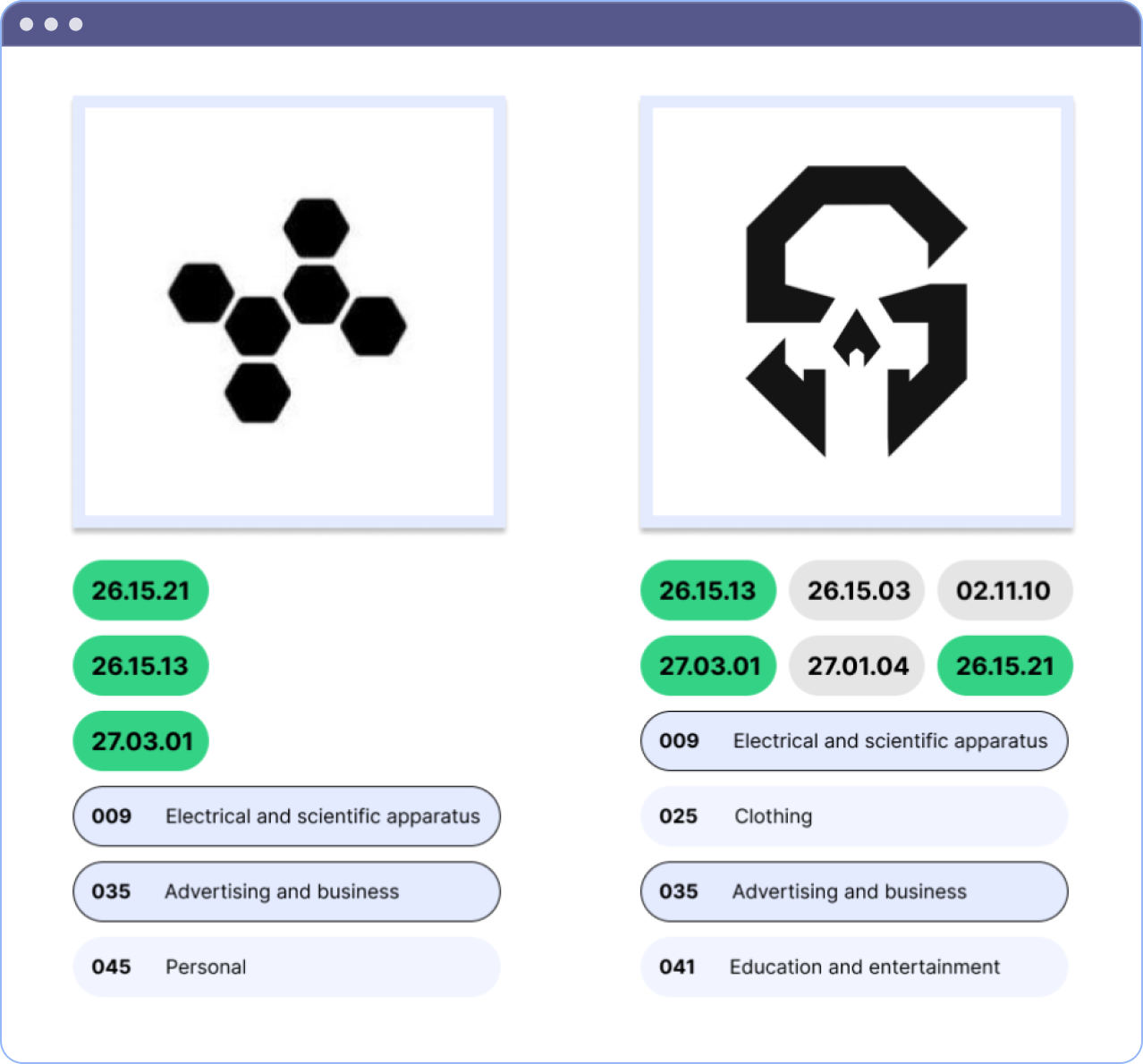How Much Does A USPTO Trademark Design Search Cost?
1Search for free via the USPTO
2Order a search from an expert
3Use an AI-powered self-service search engine
The cost of a USPTO trademark design search (also known as a logo search, figurative search, or [trademark] image search) can range anywhere from $0 to $1,000+ per search.
“Free” isn’t always the least expensive option.
The United States Patent and Trademark Office (USPTO) provides free access to a searchable trademark database known as the Trademark Electronic Search System (TESS).
TESS is not searchable by image; the database can only be searched by text. To make the process even more uniform than “describe the logo in words,” there are a series of “design search codes” that are used to search for visually similar trademarks.
A design search code is a six-digit number that is used to classify and search for the prominent design elements in a trademark.
A design search code consists of three elements: the category, division, and section. The table below shows category 01 division 01 and the fourteen related sections.
| Category | Division | Section | Design Search Code | |
|---|---|---|---|---|
| 01 Celestial bodies, natural phenomena, geographical maps | 01 Celestial bodies, natural phenomena, geographical maps | 01 | Stars with three points | 01.01.01 |
| 02 | A single star with four points | 01.01.02 | ||
| 03 | A single star with five points | 01.01.03 | ||
| 04 | A single star with six points | 01.01.04 | ||
| 05 | Stars with seven or more points | 01.01.05 | ||
| 06 | Stars with rays or radiating lines | 01.01.06 | ||
| 07 | Stars with tails or comets | 01.01.07 | ||
| 08 | Stars representing a human face or head of an animal | 01.01.08 | ||
| 09 | Two stars | 01.01.09 | ||
| 10 | Three or more stars | 01.01.10 | ||
| 11 | Incomplete stars | 01.01.11 | ||
| 12 | More than one star with four points | 01.01.12 | ||
| 13 | More than one star with five points | 01.01.13 | ||
| 14 | More than one star with six points | 01.01.14 | ||
| Specific Guidelines | ||||
| Stars include asterisks (*) and compass points. | ||||
| Stars and asterisks (*) used as small, inconspicuous design elements functioning as punctuation or parts of letters should only be coded in 29.01.07. | ||||
| Many star designs are cross-coded in the appropriate section(s) of Division 01.01 and in an appropriate section of Category 26 (Geometric figures and solids). | ||||
| Stars grouped in circles, semi-circles, ovals or other geometric figures are coded in 01.03.03 exclusively. Do not code these designs in 01.01. | ||||
| Stars in flags are not coded in 01.01. Flags are coded in 24.09. Stars in shields or medals are not coded in 01.01. Shields are coded in 24.01 and medals are coded in 24.07. | ||||
| Rays or radiating lines are not points of the stars. | ||||
| A star representing a human face or the head of an animal is not cross-coded with humans in category 02, with animals in category 03 or in any other section in 01.01. | ||||
The idea is straightforward: if the database can only be searched with text, then it makes sense to standardize the way in which design marks are described in words.
Challenges Faced Using Design Search Codes.
However, sometimes very similar looking logos can be coded differently. For example:
Despite the differences in the number of points on the stars, the applicant’s trademark looks very similar to the registered trademark owned by Louis Vuitton, which may result in a §2(d) refusal issued by the examining attorney, or an opposition filed by the registrant on the grounds of likelihood of confusion.
Other times, searching is made more challenging when the design search codes aren’t specific enough.
While diamonds, squares, rectangles, and quadrilaterals are all coded as separate divisions under Category 26 (geometric figures and solids), all polygons with five or more sides are coded together under a single Division: 26.15.
| Table of Divisions in Category 26: Geometric Figures and Solids | |
| Circles | 26.01 |
| Ovals | 26.03 |
| Triangles | 26.05 |
| Diamonds | 26.07 |
| Squares | 26.09 |
| Rectangles | 26.11 |
| Quadrilaterals | 26.13 |
| Polygons (geometric figures with five or more sides) | 26.15 |
| Lines, bands, bars | 26.17 |
| Geometric solids | 26.19 |
However, not all polygons with five or more sides look similar, as is shown in the example below:
There are no divisions or sections that distinguish regular polygons from irregular polygons (i.e., polygons with equal sides vs. polygons with unequal sides) or the number of sides beyond 5+. Furthermore, because there are over 54,000 trademarks in category 26 division 15, it can be tedious and time-consuming to sift through results looking for potential conflicts.
Time Is Money
The cost of running a clearance search and drafting an opinion is equivalent to about three hours of work.
| 2021 Attorneys’ Fees Source: AIPLA, Report of the Economic Survey 2021 | ||
| Trademark Clearance | Hourly Rate for IP Work | |
| Average (Mean) | $1,382 | $435/hour |
| Median | $1,200 | $400/hour |
Unfortunately, it can sometimes take more than three hours to run your searches with the proper queries, analyze the results, and compile the relevant findings into an opinion letter for your client. While you need to make sure you’ve searched as thoroughly as possible for your client, you also deserve to be compensated for your work.
As a result, a paid trademark search option may be more cost-effective for you and your clients.
Let The Experts Handle It: Specialist Search Services
One paid option that’s available to you is to order a search performed by an expert trademark researcher. Pricing for these services varies from provider to provider and depends on the number of classes and how quickly you need the results.
The average price for a single-class USPTO trademark design search with a 3-day turnaround time is $614 per search.
| Expert Search Costs: Cost per search USPTO Trademark Image Search, 3-day Turnaround, Single-Class | |||
| Provider | Cost | Classes | Turnaround Time |
|---|---|---|---|
| $745 | 1 Class | 3 days | |
| $840 | 1 Class | 3 days | |
| $492 (~€480) | 1 Class | 3 days | |
 Markify Markify | $379 | 1 Class | 3 days |
| Average: | $614 | ||
Faster turnaround times and additional classes can increase the price of ordered searches:
| Provider | Cost | Classes | Fastest turnaround time available |
|---|---|---|---|
| $1,955 | 1 Class | 4 hours | |
| $2,520 | 1 Class | 4 hours | |
| $974 (~€960) | 1 Class | Same-day (on request) | |
 Markify Markify | $379 | 1 Class | 3 days (no rush available) |
| Provider | Cost | Maximum classes | Standard turnaround time |
|---|---|---|---|
| $2,435 | All Classes | 3 days | |
| $1,840 | 4-15 Classes | 3 days | |
| $1157 (~€1,140) | All Classes | 3 days | |
 Markify Markify | $1705.5 | 20-30 Classes | 3 days |
| Provider | Cost | Maximum classes | Fastest turnaround time available |
|---|---|---|---|
| $6,580 | All Classes | 4 hours | |
| $5,065 | 4-15 Classes | 4 hours | |
| $1949 (~€1,920) | All Classes | Same-day | |
 Markify Markify | $1705.5 | 20-30 Classes | 3 days (no rush available) |
The advantage of paying for an ordered search is that your time can be spent on other work while you wait for your client’s search report to be delivered. The disadvantage of an ordered search is that it may be too expensive for your clients to afford.
While established enterprises may be able to afford these searches without a second thought, these costs can be prohibitive for new entrepreneurs and first-time filers. The result is inequity in access to high-quality legal services. A fundamental idea of a “creator economy” is that anyone can participate and benefit from their innovations thanks to the IP system, but high costs can discourage new creators and widen the existing gaps between those who have the means and those who do not.
Consider, too, that oftentimes more than one search is required. This is especially common with client filing on an intent-to-use (ITU) basis. First, they may have several designs in mind and would like to know which one would have the lowest likelihood of refusal. Another common scenario is when the first paid search reveals a conflict that would likely preempt a successful registration. Ultimately, it may be best to start over with a new design, but this quickly becomes frustrating and expensive for your clients. Even though you’re trying to do right by your clients, it can be hard to convince them that $379-$840 per single-class search is a reasonable expense, especially when non-law firm trademark services advertise costs of $599 (Legal Zoom) or $799 (Trademarkia) for a search and registration.
Fortunately, advancements in technology are making trademark clearance searches faster and more cost-effective, allowing you to provide high-quality services for your clients at rates they can afford.
Better, faster, cheaper: the promise of AI for trademark searching, screening, and clearance.
Most expert search services are combining AI with design search codes for their “most comprehensive” service offerings to improve the quality of the results. Even better, AI is improving the quality of self-service options, providing you with opportunity to save time and money as you help your clients.
AI can reduce the amount of human effort involved in running a search, such as using algorithms to rank the search results in meaningful ways. Equipped with the proper tools, attorneys can now run high-quality searches themselves.
Image recognition technology for trademark law.
Advancements in AI have improved image recognition technology, which can replace the need for design search codes in trademark clearance.
Image recognition technology provides you with the ability to use an image as the input for a search query. This simple operation eliminates the challenges involved with trying to describe an image in words and deciding which design search codes to use, which makes trademark research much more efficient. However, developing image recognition technology for trademark searching isn’t easy.
The emergence of “search by image” for trademark research.
Google released its reverse image search in 2011. To this day, it is for searching visually similar images. The results seldom contain trademark images, let alone trademark information.
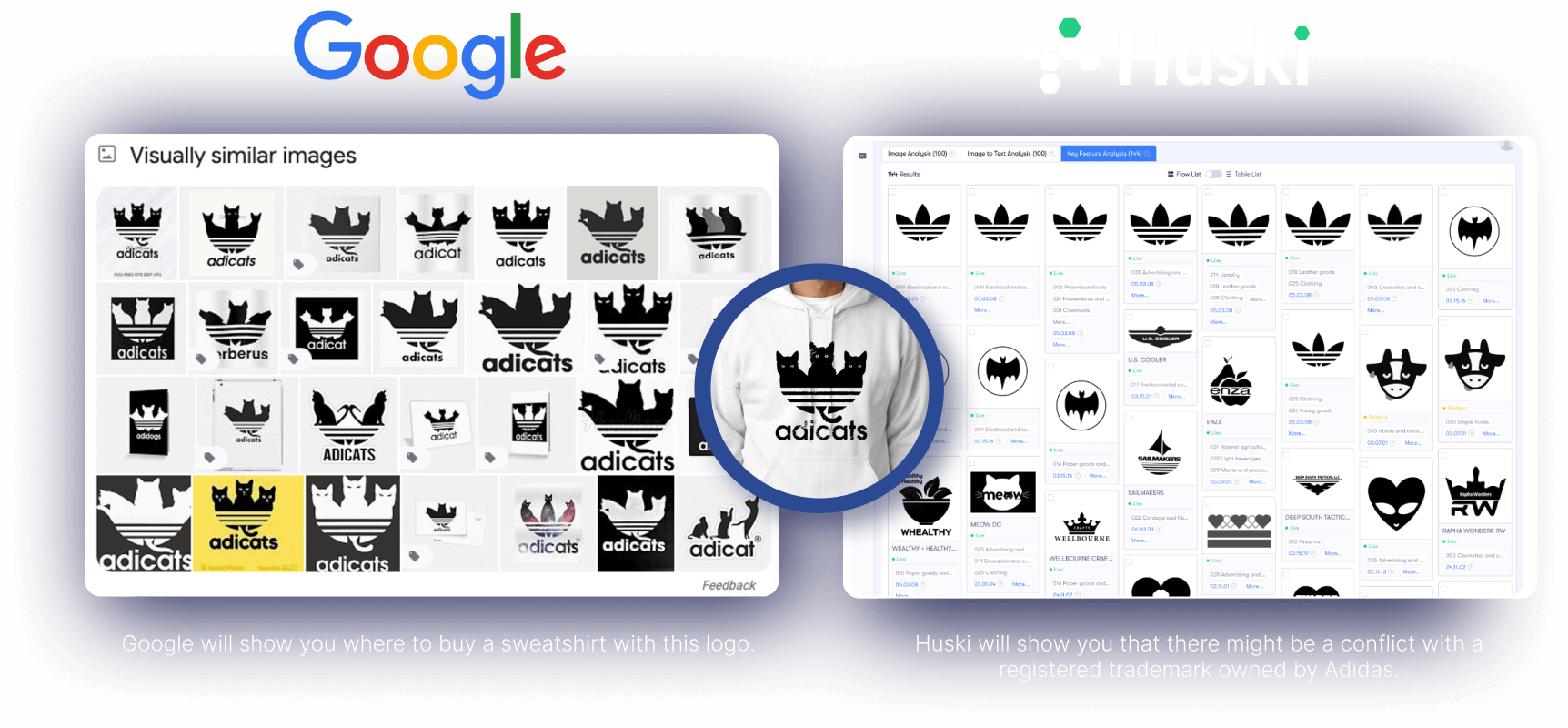
In 2013, an Australian company called TrademarkVision released the first image-based trademark search engine in 2013. TrademarkVision was then acquired by Clarivate in 2018, following the 2017 release of CompuMark’s TM go365™ image search, which was powered by TrademarkVision.
Markify was the next company to provide their users with search-by-image functionality, announcing the release Markify 2.0 in May of 2020.
At this same time, a couple AI engineers in the Silicon Valley formed a company called Huski and began the initial research and development on a model smart enough to recognize any trademark from any image, no matter how blurred or distorted the image may be.
Next, Fovea IP announced the release of their own AI-powered trademark image search in June 2020, and Corsearch released LogoCheck™ in April 2021 following the acquisition of several brand and content infringement protection solutions.
Huski’s product became market-ready in January 2022, powerful enough to accurately recognize over 1,000,000 unique trademarks from real-life images – all without any training from humans. This lack of human involvement significantly reduces the “learning costs” associated with image recognition technology and allows Huski to offer highly accurate trademark image searching at a fraction of the price of any other provider in the space.
AI-powered, self-service USPTO design mark search costs | ||||
| Provider | Pricing structure | Estimated monthly cost | Sample Search Results | |
|---|---|---|---|---|
| Based on 3 image searches per month | Based on 2 text searches + 1 image search per month | |||
| $475 per search | $1,425 per month | $875 per month = ($200 *2) + $475 | 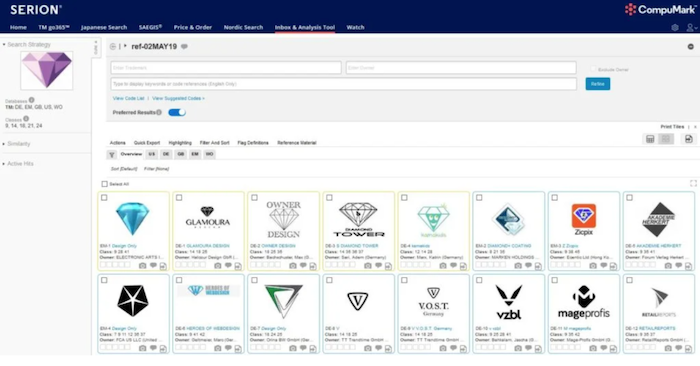 | |
| "Contact us" | Unknown | $1027 per month | 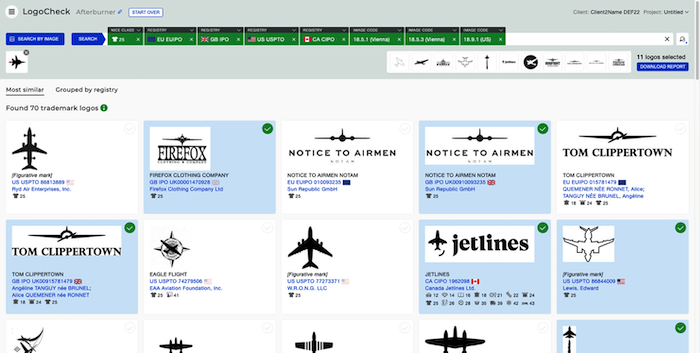 | |
| $1,522 per search ~ €1500 | $4,500 per month | $4,500 per month = (1500 € * 2) + 1500 € |  | |
 Markify Markify | $109 per search | $327 per month | $327 per month = ($129 * 2) +$109 | N/A |
| $299 per month for unlimited USPTO trademark searches | $299 per month | $299 per month | 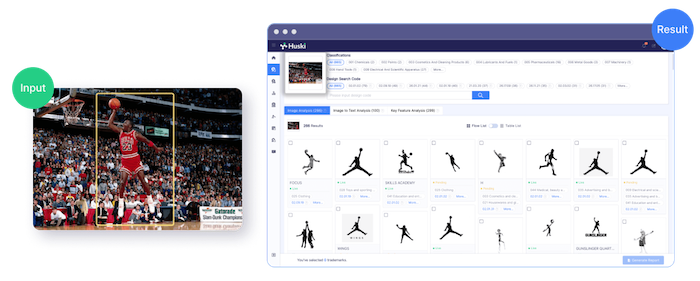 | |
*Markify and Corsearch include state register searches in their pricing for text searching; Clarivate, Fovea IP, and Huski provide pricing exclusively for USPTO text searches. (NB: All prices for image searches are exclusively USPTO; no common law or state records are included for any provider listed.)
Corsearch doesn’t list their costs for LogoCheck™ in their primary pricing guide, but we can make estimates based on what they do list. Corsearch offers unlimited online text searches for $12,320 per year (USPTO + state), which works out to about $1,026.67 per month. It can be estimated that their image searches would be priced similarly or higher.
Markify specifies a limit of 5 classes per search and a +2.5% charge for each additional class.
AI-powered trademark image searches are priced differently by different providers, making them harder to compare. To paint a clearer picture of these prices, the table above shows the advertised pricing in the second column, and the third and fourth columns provide estimated monthly costs based on three image searches per month and two text and one image search per month, respectively. Huski is the least expensive option, offering unlimited text and image searches for just $299 per month.
It's worth noting that there are a few providers who have offered self-service trademark searching, but no image recognition technology. TrademarkNow (founded 2012: Helsinki, Finland) embraced AI and released a self-service tool in May 2019 just before they were acquired by Corsearch in September 2020. TM TKO was another provider that entered the industry with a self-service offering in 2014, but their platform still relies on design search codes to search for design marks.
Choosing what’s best for you.
Many lawyers are intrigued by the possibilities AI may be able to offer, such as reduced costs and faster turnaround times. Lower cost and improved efficiency make for a better client experience and allow you to stay competitive against the growing body of non-law-firm trademark registration service providers.
There’s no singular right answer for what your best option is for your clearance searches; you have to decide that for yourself based on your clients’ budget and requirements.
Paid clearance search options tend to be less expensive than the cost of the time it takes to run an image search through TESS. AI-powered self-service searches are less expensive than professional ordered searches, but some lawyers are still hesitant to trust an algorithm over human judgment. AI should never replace humans; it should only make a human’s job easier. In this case, AI can find relevant results sooner.
Tips for evaluating image recognition technology for trademark searching.
Not all images are as “searchable” as others – some can cause problems for image recognition models. For example, think about every time you have to “Click on all images that contain a crosswalk” when you submit a form. Those images of crosswalks are obscured, off-center, etc. – basically, they’re more difficult for computers to recognize. These challenging images are great for testing the quality of image recognition technology.
You can view a compilation of challenging examples here.
At Huski, our expertise is image recognition technology, and we’re very proud of our model’s accuracy and that we were able to engineer it in a way that keeps the costs low for you and your clients. We would love to invite you to run your own searches with Huski, and we’d welcome any feedback you may have.
About Huski Inc.
Huski Inc. is a new legal technology company specializing in solutions that help trademark attorneys help their clients. Its startup-minded team consists of engineers and intellectual property litigation professionals, all of whom strive to increase accessibility to brand protection services for IP lawyers and creators at all stages. Big or small, the brands of an IP firm’s clients deserve protection. Huski believes that AI and big data can upscale IP services efficiently and cost-effectively. For more information, please visit www.huski.ai.


